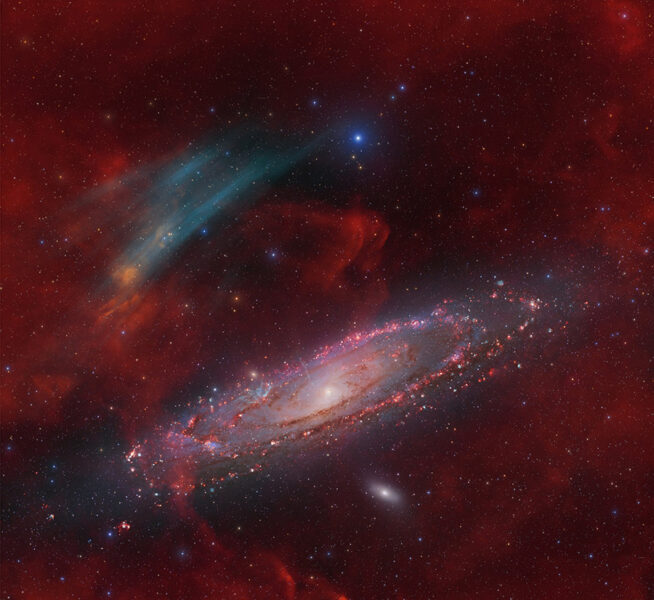
Using sophisticated amateur equipment, Xavier Strottner and Marcel Drechsler have already found dozens of previously unknown planetary nebulae in our galaxy. Last fall, analyzing images obtained by Yann Sainty, they stumbled upon a much larger structure, just 1.2 degrees southeast of Andromeda's nucleus. The arc extends over 1.5 degrees and ends close to the naked-eye star Nu (ν) Andromedae (the blue star at the top of the photo).
Sainty used a 4.2-inch Takahashi refractor and a large-format ZWO CMOS camera outfitted with a narrow-band filter that only transmits the greenish, 500.7-nanometer light emitted by oxygen atoms that have lost their outermost two electrons (the [OIII] line). His wide-angle images added up to a total exposure time of more than 100 hours. Subsequent images, made with five different setups in France and the United States, have confirmed the existence of the [OIII] arc, which is now known as Strottner-Drechsler-Sainty Object 1 (SDSO-1).
Because of the arc's huge angular size and its extremely low surface brightness, professional surveys hadn't previously detected it. A brief paper describing the discovery, written by the three amateur astronomers together with professional researchers, has appeared in Research Notes of the AAS.
So what is it? No one knows. It's not even clear that the arc is actually related to the Andromeda Galaxy. In principle, it could be part of a nearby, old planetary nebula or supernova remnant in our own Milky Way. However, in that case you would also expect to detect red hydrogen-alpha emission. While such deep exposures (which are part of the composite photo shown above) reveal many emission nebulae in Andromeda's spiral arms, as well as faint galactic structures in the foreground, they don't show the newly discovered arc.
The team speculates that SDSO-1 could be a bow shock in the stellar halo of M31, caused by its interaction with the halo of the Milky Way — a result of the two galaxies closing in on each other at some 100 kilometers per second (200 million mph). Or it could be a tidal feature, related to streams of stars in Andromeda's halo. Follow-up spectroscopic observations should reveal the arc's distance and may shed light on its origin.
"It's all very impressive," says Pieter van Dokkum (Yale University), "especially the fact that they organized follow-up observations to confirm [the discovery]. My guess would be that it's gas in the Milky Way, but of course it would be much more interesting if it's actually close to M31."
Within a few weeks, the first part of an upgrade of van Dokkum's Dragonfly Telephoto Array in New Mexico (see the May 2019 issue of Sky & Telescope) will become operational. "Eventually, Dragonfly will consist of 120 telephoto lenses, each one with tunable, extremely-narrow-band filters, including hydrogen-alpha and [OIII]," he says. "We're already discussing to image M31 as soon as our first mount is up and running."



Reader Comments